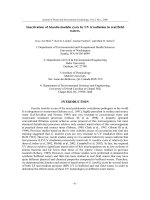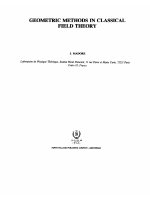MAKING DECISION IN OIL FIELD REPORT
Bạn đang xem bản rút gọn của tài liệu. Xem và tải ngay bản đầy đủ của tài liệu tại đây (1.25 MB, 46 trang )
VI ETNAM NATI ONAL UNI VERSI TY, HO CHI
MI NH CI TY
HO CHI MI NH CI TY UNI VI ERSI TY OF
Pe t rTECHNOLOGY
ol e u m Pr oj e ct
Topic
MAKI NG
I N DECI
OI L FISI
ELD
LI FE
ON
CYCLE
As s oc. Prof . Dr. Tran Van Xuan
Advisor
N guye n The Vinh- Bui N hat
HCMC,
1/ 2016
Thinh
Decision Analysis
Recovery Factor
Reserves
CONTENT
Petroleum
Economic
EIA
DECISION ANALYSIS
What is Decision Analysis (DA)
• The historical origins of decision analysis can be partially traced to
mathematical studies of probabilities in the 17th and 18th centuries by
Pascal, Laplace, and Bernoulli.
• However, the applications of these concepts in business and general
managementn appeared only after the Second World War
• Decision analysis is a scientific and practical method for making important
decisions.
• Decision analysis involves identification, clear representation, and formal
assessment of important aspects of a decision and then determination of
the best decision by applying the maximum expected value criterion
DECISION ANALYSIS
Why use DA?
DECISION ANALYSIS
Steps of DA?
• Determine the goal or objective
• Develop a list of possible alternatives
• Identify possible future conditions or states of nature for each
random variable
• Determine or estimate the payoff ( or value )
• Estimate the likelihood of each possible future condition for each
random variable.
• Evaluate the alternatives according to the goal or decision criterion,
and select the best alternative.
DECISION ANALYSIS
Advantages of DA?
DECISION ANALYSIS
What make a good
decision maker
ANALYZE
DECISIVE
SKILLS
WISE
INFORMATIVE
DECISION ANALYSIS
Application of DA in life
Apppplied
mostly in
industry and
manufature
DECISION ANALYSIS
Decision tree
• A decision tree is a graphical representation of the decision
variables, random variables and their probabilities, and the payoffs
• Decision trees are particularly useful for analyzing situations that
involve sequential or multistage decisions
Decision tree for a facility building
Analyze the decisions from right to left
1.Determine which alternative would be selected for each possible
2. Determine the product of the chance probabilities and their respective payoffs fo
the remaining branches
3. Determine the expected value of each initial alternative
DECISION ANALYSIS
Expected value
The expected value for an uncertain alternative is calculated by
multiplying each possible outcome of the uncertain alternative by its
probability, and summing the results.
Expected
value decision
in developing
temperature
sensor
Example :
Product decision. The expected values for the Special Instrument Products
decision are designated by “EV" . These are determined as follows:
1) For the temperature sensor alternative:
0,5 x $900.000 + 0,5 £ ( - $100.000) = $400.000
2) for the pressure sensor alternative:
0,8 x $390.000 + 0,2 x ( - $10.000) = $310.000
3) for doing neither of these $0.
The temperature sensor should be developed.
DECISION ANALYSIS
Sensitivity analysis
Determining the range of probability for which an alternative has the
best expected payoff.
A
Alternative B
C
4
16
12
State of Nature
State of Nature
#1
#2
12
2
8
• The graph shows the range of values of P2 over which each alternative
is optimal.
• for low values of P2 → B is the best
• for intermediate values of P2 → C is the best
• for higher values of P2 → A is the best
Sensitivity analysis of 3 alternatives
• To find exact values of the ranges, determine where the upper parts of
the lines intersect.
• Because these are straight lines, they have the form :
y = a + bx
Where:
a is the y-intercept value at the left axis
b is the slope of the line
x is P2
The slopes and equations are:
#1
A 4
B 16
C 12
#2
12
2
8
Slope
12-4=+8
2-16=-14
8-12=-4
Equation
4+8P2
16-14P2
12-4P2
Equations of 3 alternatives
+ Alternative B is best from the point P2 = 0 to the point where the
alternative B line intersects the alternative C line:
16 − 14 P2 = 12 − 4 P2 → P2 = 0.4
+Alternative C is best from that point until its line intersects alternative A’s
line :
4 + 8 P2 = 12 − 4 P2 → P2 = 0.67
RECOVERY FACTOR AND RESERVES
Recovery factor
Estimate of recoverable oil
Recovery factor =
Estimate of in-place oil
Drive mechanism has the greatest geological impact on recovery factor
Decide which drive mechanism is most likely from the geology of the prospective
reservoir system
Narrow the recovery factor range by predicting the thickness of the reservoir by port
type
Field analogue
Analytical models
Reservoir simulation
RF = RFP + RFS
Drive mechanism
Depletion
Solution gas
Expansion gas
Gas cap drive
Water drive
Bottom
Edge
Gravity
Primary recovery factor
drive mechanism (%)
18–25
2–5
20–40
20–40
35–60
50-70
The secondary recovery factor
Soi − Sor
RFs = ED ×
×100%
Soi
where
ED:
Macroscopic
Efficiency
Displacement
Soi − Sor
×100% : Microscopic sweep
Soi
Efficency
Estimating recovery factor by analogue
RECOVERY FACTOR AND RESERVES
Reserves
Proven Reserves
1P
P90
Unproven Reserves
2P
P50
3P
P10
Schematic graph illustrating petroleum
volumes and probabilities
Resever Estimation
Volumetric
Material Balance
Change in pore volume = Change in
oil volume + change in free gas volume
+ change in water volume
The material balance technique
mathematically models the reservoir
as a tank. This method uses limiting
assumptions and attempts to
equilibrate changes in reservoir
volume as a result of production
Paremeter of HCIIP
Ultimate recovery (STB) = HCIIP x RF
Production History
Solving for
Rate of production
Cumulative
production
Life of reservoir
Exponential
qt = qi e
Np
Hyperbolic
− Dt
qt = qi ( 1 + nDi t )
q ni
Np =
qi1− n − qt1− n )
(
( 1 − n ) Di
qi − qt )
(
=
D
1 qi
t = ÷ln ÷
D qec
qt = Rate of production at time t
qi = Rate of initial production
qec = Economic limit rate of production
Np = Cumulative production
−1/ n
n
q
1
t = i ÷ −
qec nDi
D = Decine rate (decimal).
Di = Initial decline rate (decimal).
t
= Time (years).
Expected curve for discovery
For convenience, the probability axis may be split into three equal sectors in order
Again
for convenience,
the curve
three values
chosen
cumulative
to be able
to represent the
by just correspond
three points.toEach
point
represents the
probabilities
(85,
and 15%).
average value
of 50
reserves
within the sector.
Expection curve for a discovery
Expected curve for exploration
When an explorationist constructs
an expectation curve, the above
approach for the volumetrics of an
accumulation is taken, but one
important additional parameter must
be taken into account : the
probability of there
being
hydrocarbons present at all
Expectation curve for an exploration prospect.
PETROLEUM ECONOMIC
Project cashflow
Typical revenue and expenditure items
Revenue items
Expenditure items
Gross revenues from sales of hydrocarbon Capital expenditure e.g platform, facilities,
wells (asssets with lifetime > 1year)
Tariffs received
Operating expenditure e.g maintenance,
salaries, insurance, tariffs paid (asset with
lifetime <1year)
Payments for farming out a project or part
of a project
Goverment take, e.g :
-royalty
-tax
-social contribution
Project cashflow of a filed life cycle









